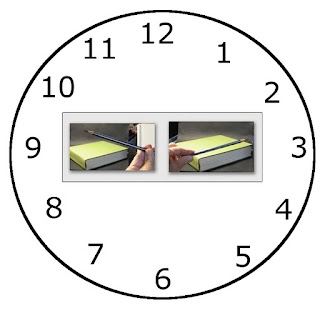How much do you think about the rules of linear perspective when you draw or paint?
One-point, two-point, three-point—just establishing a horizon line and finding vanishing points can be such a chore that many artists find it too stifling to deal with. But there’s a way to find the correct angles of perspective for any object without having to memorize a single rule, and it’s something that artists have been using for centuries: the angle finder.
A brush handle, pencil, finger or even a stick can be turned into an angle finder. All it takes is holding your angle finder at arm’s length, closing one eye, and aligning it with the edge of the object you’re planning on drawing.
 |
| Locating the angle of the an oak tree trunk by using an brush handle as an angle finder. |
Finding the angle is simple enough, but sometimes there’s a disconnect that occurs somewhere between reading the angle and translating it to a drawing or painting. Years ago I recognized this problem among a number of my college students. I discovered that when students were unsure about the tilt of an angle they were looking at, they could see it better if they could label it. (An odd thing, labeling: something we humans seem to need.) To enable an accurate labeling system, I came up with a method to teach angle finding by equating each angle to a number on a clock face.
It works like this: stand in front of a clock face holding your
angle finder at arm’s length. Position it so that it becomes like another hand
on the clock as if connected to the center. Looking with one eye closed, align the angle finder toward a number on the clock by rotating it either clockwise or counter clockwise to find 7 o’clock, then 9, 12 and 2. You have just read four perspective angles.
Now try this: Lay a book on a table, pick up a pencil to use as an angle finder, stand back three or four feet, hold the pencil on the eraser end, straighten your arm so your elbow won't bend, close one eye, then rotate your pencil until it aligns with the edge of the book's cover. Look at where the pencil is pointing, then name the angle according to its clock number. Try this again along the front edge of the book cover.
 |
| Keep your attention on the pencil so that it doesn't flop forward or point backwards. It must move only clockwise or counter clockwise, else it will mislead you. |
 |
Try doing a simple line drawing of the book, labeling the angle of each line like I've done in the drawing below.
Practicing the exercise several times can give you a idea of how the system works. After feeling secure, try the same exercise using a building as your image.
Just like any skill, the more you practice this the more adroit you’ll become at using it. Eventually you will have the clock positions firmly engraved in your memory and you’ll no longer need the clock diagram to help you out.
You will also discover that you’re recognizing angles in many more places, and that it’s much easier to draw them accurately—without ever being concerned about the actual rules of perspective again.
(Disclosure: this tutorial is an adaptation of a tutorial I wrote for Empty Easel in October, 2008.)
*********************
See Dianne's latest work on One Artist's Journey
**********************



8 comments:
Dianne! That is brilliant in its simplicity. I never thought to equate the angle with the time on the clock and doing so distills that (the position of the angle) down to its essence. Thank you-I can't do complex:):):)
Thanks, Libby. It is, indeed, simple, and it works. So glad you found this helpful.
I enjoyed reading it again, Dianne! It's incredible how many times I usually need to reread, practice something new until I 'get it'.
Dianne,
Using the clock face is an easy to understand and remember reference. Perspective and scale have been driving me crazy in a recent drawing of a train and train station. This will help so much!
Thank you,
Nanina
Hi Dianne
Referring to a clock face really makes learning perspective easy and I'll use this method from now on in my sketchbook journal classes in Mendocino. I've been trying to simplify this instruction for 5 years and at last! the quick fix for everyone! Thanks!
www.suzilong.com
It really pleases me that so many of you are finding my clock trick helpful. Suzi, use it in your teaching with my blessings.
I also will be more than happy to pitch the old one-two-and three point perspectives! Every time I see all those lines pointing in a thousand different directions, I lose hope. Your process simplifies it all! Thank you Dianne!
Thanks, Ann. Do let me know whether my little clock trick opens up new hope.
Post a Comment